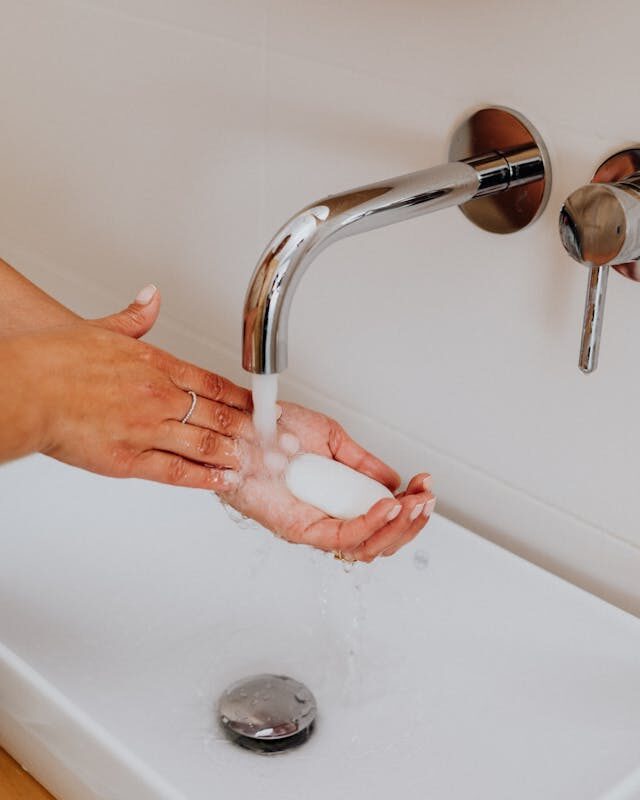You have questions about soap. We have answers for you. All sources to information have been linked within the below article text.
Does common bar soap kill bacteria and viruses?
Hand washing soap can kill some but not all germs. Using soap and water to scrub and rinse your hands and face can eliminate germs on the surface of skin by washing them away. It is said that scrubbing away dirt and germs with soap and water, as well as applying disinfectants, such as household bleach, is more effective than using disinfectants alone. (SOURCE)
Does a used bar of soap contain germs?
A bar of soap that you would rub on your skin to clean it likely contains many bacteria. However, many of the bacteria would be the same as the millions that already exist on your skin as part of your protectant biodome of friendly skin bacteria that fight pathogens.
It is interesting to note that the concept of “your” germs comes into play here. The CDC does not recommend sharing a bar of soap. Certain rare infections such as staph, or even the common cold, can be spread in this manner, especially if you cut yourself and the bacteria enters your blood stream via the cut.
Ways to minimize the spread of germs when using bar soap:
Rub the soap directly on your body rather than soaping up a wash cloth.
If you scrub with a wash cloth, you should replace with a clean, dry one each time you shower. Wet wash cloths that have been hanging in the damp bathroom can grow unwanted bacteria.
Keep your bar soap dry when not in use. You can do this by placing it on a raised draining board made for soap.
Is bar soap effective at eliminating germs?
The Centers for Disease Control and Prevention assert that regular soap effectively removes germs by scrubbing them away. They recommend scrubbing for a minimum of 15 seconds. This is how long it takes for the surfactant compounds in soap to begin physically removing dirt and germs from your skin. (SOURCE)
What’s in the recipe for soap?
There are many different soap recipes, but the various ingredients are all basically similar.
The recipe for soap combines fats and oils with a solution that basic in pH. The most commonly used basic solutions for soap making are sodium hydroxide and potassium hydroxide. Either of these scientific terms can be referred to as lye, though it is much more common in modern times to make soap from sodium hydroxide rather than potassium hydroxide.
Where can I get a good recipe for soap?
There are many exciting homemade soap recipes to try online. These include ingredients that both cleanse and nourish the skin, including olive oil, shea butter, coconut oil and almond oil to name some substances that work as the “fat” component of soap.
You can add pulverized herbs such as lavender and rosemary to your homemade soap recipes. Homemade soaps can be scented with essential oils for their aromatherapy benefits and healing, antioxidant properties.
Why is soap made from fat?
Fat acts as an attractant for impurities, dirt and toxins, drawing these out so that you are able to scrub and wash them away with water.
The hardness of your homemade soap has to do with the type of fat that it’s made from. Polyunsaturated oils such as olive oil make a softer soap that melts more quickly in water, though it does tend to be more nourishing to the skin due to the presence of omega-3 fatty acids.
Harder soaps are made from saturated fat, such as coconut oil. (SOURCE)
What is lye and why is it used in soap?
Lye is another name for sodium hydroxide or, less commonly, potassium hydroxide. Lye is a common ingredient in soap. It is a highly caustic substance that can burn skin, destroy tissue and destroy the cornea of the eyes if direct contact is made.
The basic use of lye in soap involves dissolving it in water, letting it cool, and then adding this solution to oils and butters.
Lye dissolves grease, making it ideal as a soap ingredient as well as for use in tough cleaning applications. Lye, or sodium hydroxide, is commonly found in oven cleaner. It is so powerful that it is used by waste management companies to dissolve animal carcasses in order to prevent overcrowding of landfills.
You can purchase lye as an ingredient in your recipes for homemade soap. It is available in dissolvable pellet type form.
If you opt to make soap at home using simple ingredients, please be extra careful when handling lye which can damage skin and eyes. Don protective eyewear and follow instructions carefully. Do not permit children into the area when you are working with lye.
Why is liquid soap more popular than bar soap?
The notion that liquid soap cleans better likely comes from the idea that the soap is protected in a sealed container. With a bar of soap, many hands come into contact with the soap, and those hands may have dirt, germs and other contaminants on them.
The soap that you use to wash your skin does not need to be liquid soap if you don’t have it. You can get yourself clean using good old bar soap like your great grandma did when she was young.
